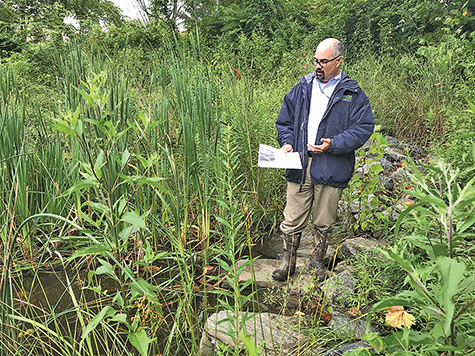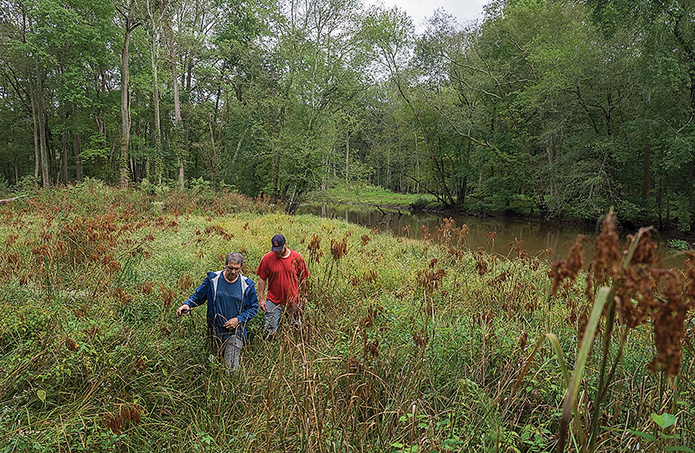By Jeremy Cox
Bay Journal
Erik Michelsen stopped his county-issued white Jeep Cherokee on the side of the road in a leafy neighborhood south of Annapolis, then plodded down into a ravine. He followed a trail through a tunnel of oak trees and rare Atlantic white cedars. The air was heavy with the scent of dew. At the bottom, Michelsen emerged in a picturesque scene: a babbling stream slightly too wide to leap across that was strewn with rocks, ranging in size from golf balls to microwaves.
If it seemed too natural to be natural, it was. In 2005, the state of Maryland and Anne Arundel County collaborated on a nearly $1 million project that transformed two failing stormwater ponds into “Wilelinor Stream,” named after the adjoining subdivision. Bulldozers reshaped the land, workers sowed underwater grass beds and dump trucks hauled in tons of sandstone boulders and river rock.
“It’s essentially creating systems that slow the water down through the valley, stack the water up, provide an opportunity for it to be processed and slowly released down to tidewater at Church Creek and the South River,” said Michelsen, administrator for Anne Arundel’s watershed protection and restoration program.
Millions to restore 655 miles of streams
Facing a 2025 deadline to clean up the Chesapeake Bay, officials in urban and suburban areas are spending millions of dollars on stream restoration projects.
The six states in the estuary’s watershed, along with the District of Columbia, have told the U.S. Environmental Protection Agency that they plan to restore a total of 655 miles of streams. The projects operate on a theory that converting upstream waters from stormwater superhighways to slow lanes would decrease erosion and encourage more water to soak into the ground, reducing the amount of nutrients and sediment heading into the Bay.
Now, there is a growing scientific consensus that stream restoration isn’t improving water quality and aquatic habitats as much as was once hoped in a highly urbanized area.
“It’s not a waste of money,” said Solange Filoso, a biogeochemist with the University of Maryland Center for Environmental Science. “But the return on investment is not as high as we thought it would be.”
Filoso has been monitoring the Wilelinor and several other reconstructed streams for about a decade. At first, she was confident she would see significant improvement in water quality. What she found was much more modest: an average reduction of 5–15% in nitrogen and 40% in sediment.
Some restorations more effective than others
Some stream restoration projects curb more pollution and others less, given the variations in construction methods and local topography, Filoso said. But she and other researchers studying projects across the mid-Atlantic have collected enough evidence to suggest that stream restoration alone can’t solve the region’s runoff problem.
“We are trying to solve a big problem … with a solution that isn’t sufficient,” Filoso said. “The solution being implemented doesn’t match the magnitude of the problem.
Since 2010, when the EPA and Bay states agreed to their most rigorous restoration plan to date, the amount of nitrogen running off urban areas into the Chesapeake has increased from 39.7 million pounds a year to 41.3 million pounds, according to the federal agency’s latest computer models. This is despite an overall 11% reduction in nitrogen from all sources, fueled largely by cuts to pollution from farms and wastewater treatment plants.
Nitrogen triggers algae blooms that cloud Bay waters, causing underwater grass beds to die back and rob the water of oxygen as they die, creating “dead zones” nearly devoid of fish and crabs. Efforts to reduce nitrogen fell short of the Bay cleanup midpoint reduction goal, registering a 30% decrease instead of 60%.
Restoration more art than science
Proponents of stream restoration say that its benefits haven’t fully come to light because the practice remains in its infancy.
“I would tell you ecological restoration is not yet a science,” said Keith Underwood, an Annapolis-based contractor who was one of the region’s pioneers in the field, starting his first projects in the mid-1990s. “It’s still very much in the era of an art.”
Joe Arrowsmith, water resources engineer with Straughan Environmental in Columbia, said it’s time for the field to evolve. “We have reached our base goals, and now it’s time to reach higher goals,” Arrowsmith said.
Restored streams only get better with time, proponents say, as the scars of construction heal and nature reasserts itself. But one improvement is obvious almost immediately: Water travels through the channels more slowly. That leads to less streambank erosion and less sediment being transported downstream. Phosphorus, another problem nutrient, clings to sediment. So it ends up staying put rather than being flushed into the Chesapeake.
Downsides
But there can be downsides, scientists caution. For instance, portions of restored streams can turn into “dead zones” themselves, Filoso said.
One of the main methods that contractors use to slow floodwater is creating a chain of pools separated by rock weirs; they’re embedded in a slope so that one trickles into the next. In warm weather, decaying plants trapped in the slow-moving water can use up its oxygen.
When water turns anoxic, or lacking in oxygen, it can flip that lingering phosphorus from a positive story to a negative one. A chemical reaction unglues the nutrient from the sediment, transforming it into a fertilizer for algae blooms, Filoso said.
“All the restorations have trade-offs,” she added.
No improvement in aquatic life
There is disagreement over whether the re-engineered streams are providing better habitat for insects, frogs and other wildlife. Studying more than a dozen stream sites in Maryland, EPA researchers Rebecca Cope and Greg Pond found that restored streams weren’t improving aquatic life and, in some cases, were leading to less diversity. All that could be found in some were worms and maggots, Pond said.
Again, the issue seems to be the low amount of oxygen in some restored streams, he said. “The thing with dissolved oxygen is it’s a kill switch. You get below 2 milligrams [per liter], you get a lot of death with macroinvertebrates that may have colonized,” Pond said during a recent conference call with the Chesapeake Bay Program stream health panel.
Underwood was listening, growing frustrated. In an interview later, he called it unfair for scientists to evaluate all restored streams with the same criteria when great variations exist among them. Truly “restored” streams, known in the industry as regenerative stormwater conveyances, or RSCs, re-establish hydrologic connections between channels, their floodplains and the groundwater, he said.
“You saw that our detractors were calling a lot of things RSC that were not RSC,” Underwood said. In one case, he added, “they were studying bugs at the outfall pipe from the Annapolis Mall.”
Most stream restoration sites in Maryland
Ground zero for the debate is Maryland’s highly developed Western Shore. Three out of every five miles of streams recommended for restoration across the Chesapeake’s six-state watershed are in Maryland cities and towns.
As he drove to another stream restoration site a couple of miles away from Wilelinor Stream, Michelsen explained why the technology has caught on there. Anne Arundel’s landscape, he said, unites two disparate features: loose, sandy soils and a Piedmont-like terrain. During heavy rains, that combination often leads to torrents of erosion that have scoured small streams and detached them from natural floodplains.
He stepped over the curb at the edge of a half-empty park-and-ride lot and tromped a few dozen yards to where a grassy margin fell away into a gently sloping wetland. In 2016, the State Highway Administration rehabilitated the channel, which flows into Broad Creek.
Just about everything about the original headwaters channel was unnatural, including its very existence; it was carved by gushing waters turned loose by a dam break in the 1980s, Michelsen said. By the 21st century, the uncontrolled water had scoured a channel as deep as 6 feet.
The entire restoration area measures a handful of acres and is responsible for the drainage of a watershed spread across 250 acres – roughly half of it consisting of impervious cover, such as parking lots, highways and buildings.
Still, the wetland seemed to teem with life. On Michelsen’s approach, a snowy egret and green heron took flight. Pointing out the birds, he said that their presence suggests the wetland is probably full of insects as well.
Michelsen, another participant in the panel phone call, took the criticisms in stride. “I think the field is still so young, every project is sort of its own experiment.”
Anne Arundel is home to dozens of stream restoration projects, dating back more than 15 years, and officials there and elsewhere in Maryland appear undeterred by their middling results. Gov. Larry Hogan’s administration recently awarded $22 million to 18 projects designed to improve the health of waterways. At least 14 involve restoring urban streams or using similar techniques to capture and store stormwater.
Muddy Creek in Edgewater, Anne Arundel
One of the best hopes for answering questions about stream restoration lies with Muddy Creek, a tributary of the Rhode River in Edgewater, which is also in Anne Arundel County. It is one of the only sites where scientists studied a channel before the work crews arrived and after they left — a key to sorting out what impacts can be ascribed to restoration.
Workers used sand and wood chips to raise the streambed, which had fallen 12 feet below the surrounding land. They installed small berms across the width of the channel at certain points to check the flow of water. Where once there was a deep ditch, water can now overflow the banks into a surrounding marsh.
The $1 million project caused a “profound change” to the ecosystem, said Tom Jordan, a senior scientist with the Smithsonian Environmental Research Center. He collected data on Muddy Creek’s water quality for one year before and two years after the restoration.
Almost immediately, he noticed an influx of wood ducks, salamanders and frogs. The water table rose, making the bank inhospitable to tulip poplars, and they soon died. But his water samples showed the stream performing as promised in some ways, particularly in its ability to sponge up phosphorus. Nitrogen levels were down by only “marginal” levels.
The restoration had another unexpected effect — and not for the better. Portions of the stream have turned a rusty color, a symptom of iron leaching out of the rehydrated soil around it. The iron oxidizes when it comes in contact with the air at the water’s surface. The bacteria that feed on the iron deplete the oxygen in the water.
For Jordan, Maryland’s experiences with stream restoration present a larger question: Should streams suffer so that the Bay may live?
“It’s some kind of urban runoff treatment system, and it doesn’t seem right,” he said. “It seems like we should design urban development to protect the streams and not the other way around.”






Recent Comments